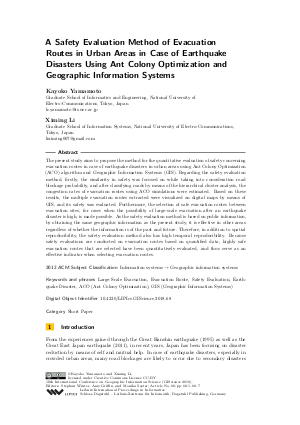A Safety Evaluation Method of Evacuation Routes in Urban Areas in Case of Earthquake Disasters Using Ant Colony Optimization and Geographic Information Systems (Short Paper)
Authors Kayoko Yamamoto, Ximing Li
-
Part of:
Volume:
10th International Conference on Geographic Information Science (GIScience 2018)
Part of: Series: Leibniz International Proceedings in Informatics (LIPIcs)
Part of: Conference: International Conference on Geographic Information Science (GIScience) - License:
 Creative Commons Attribution 3.0 Unported license
Creative Commons Attribution 3.0 Unported license
- Publication Date: 2018-08-02
File

PDF
LIPIcs.GISCIENCE.2018.68.pdf
- Filesize: 188 kB
- 7 pages
Document Identifiers
Subject Classification
ACM Subject Classification
- Information systems → Geographic information systems
Keywords
- Large-Scale Evacuation
- Evacuation Route
- Safety Evaluation
- Earthquake Disaster
- ACO (Ant Colony Optimization)
- GIS (Geographic Information Systems)
Metrics
- Access Statistics
-
Total Accesses (updated on a weekly basis)
0Document
0Metadata
Abstract
The present study aims to propose the method for the quantitative evaluation of safety concerning evacuation routes in case of earthquake disasters in urban areas using Ant Colony Optimization (ACO) algorithm and Geographic Information Systems (GIS). Regarding the safety evaluation method, firstly, the similarity in safety was focused on while taking into consideration road blockage probability, and after classifying roads by means of the hierarchical cluster analysis, the congestion rates of evacuation routes using ACO simulations were estimated. Based on these results, the multiple evacuation routes extracted were visualized on digital maps by means of GIS, and its safety was evaluated. Furthermore, the selection of safe evacuation routes between evacuation sites, for cases when the possibility of large-scale evacuation after an earthquake disaster is high, is made possible. As the safety evaluation method is based on public information, by obtaining the same geographic information as the present study, it is effective in other areas regardless of whether the information is of the past and future. Therefore, in addition to spatial reproducibility, the safety evaluation method also has high temporal reproducibility. Because safety evaluations are conducted on evacuation routes based on quantified data, highly safe evacuation routes that are selected have been quantitatively evaluated, and thus serve as an effective indicator when selecting evacuation routes.
Cite As Get BibTex
Kayoko Yamamoto and Ximing Li. A Safety Evaluation Method of Evacuation Routes in Urban Areas in Case of Earthquake Disasters Using Ant Colony Optimization and Geographic Information Systems (Short Paper). In 10th International Conference on Geographic Information Science (GIScience 2018). Leibniz International Proceedings in Informatics (LIPIcs), Volume 114, pp. 68:1-68:7, Schloss Dagstuhl – Leibniz-Zentrum für Informatik (2018)
https://doi.org/10.4230/LIPIcs.GISCIENCE.2018.68
BibTex
@InProceedings{yamamoto_et_al:LIPIcs.GISCIENCE.2018.68,
author = {Yamamoto, Kayoko and Li, Ximing},
title = {{A Safety Evaluation Method of Evacuation Routes in Urban Areas in Case of Earthquake Disasters Using Ant Colony Optimization and Geographic Information Systems}},
booktitle = {10th International Conference on Geographic Information Science (GIScience 2018)},
pages = {68:1--68:7},
series = {Leibniz International Proceedings in Informatics (LIPIcs)},
ISBN = {978-3-95977-083-5},
ISSN = {1868-8969},
year = {2018},
volume = {114},
editor = {Winter, Stephan and Griffin, Amy and Sester, Monika},
publisher = {Schloss Dagstuhl -- Leibniz-Zentrum f{\"u}r Informatik},
address = {Dagstuhl, Germany},
URL = {https://drops.dagstuhl.de/entities/document/10.4230/LIPIcs.GISCIENCE.2018.68},
URN = {urn:nbn:de:0030-drops-93966},
doi = {10.4230/LIPIcs.GISCIENCE.2018.68},
annote = {Keywords: Large-Scale Evacuation, Evacuation Route, Safety Evaluation, Earthquake Disaster, ACO (Ant Colony Optimization), GIS (Geographic Information Systems)}
}
Author Details
- Graduate School of Informatics and Engineering, National University of Electro-Communications, Tokyo, Japan
